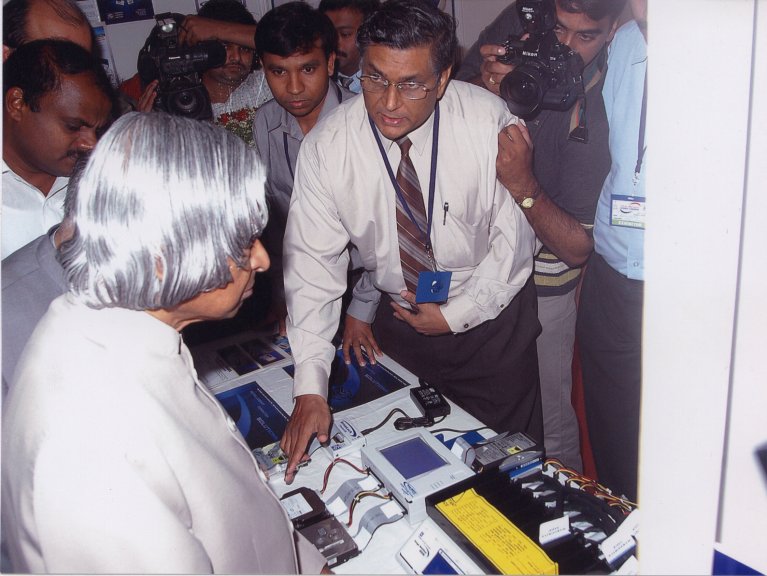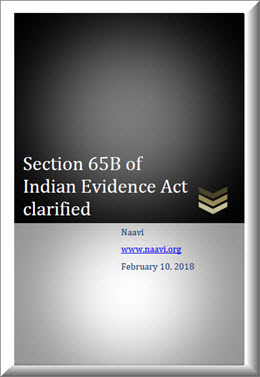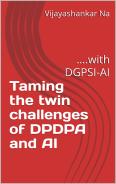On September 18, 2014, the famous P.V.Anvar Vs P.K Basheer judgement was delivered by the three member Supreme Court bench consisting of the then CJI, Kurien Joseph along with Justices R.M. Lodha and Rohinton Fali Nariman in which it was unambiguously declared as follows:
“Any documentary evidence by way of an electronic record under the Evidence Act, in view of Sections 59 and 65A, can be proved only in accordance with the procedure prescribed under Section 65B.”
“The very admissibility of such a document, i.e., electronic record which is called as computer output, depends on the satisfaction of the four conditions under Section 65B(2). Following are the specified conditions under Section 65B(2) of the Evidence Act:”
“Only if the electronic record is duly produced in terms of Section 65B of the Evidence Act, the question would arise as to the genuineness thereof and in that situation, resort can be made to Section 45A – opinion of examiner of electronic evidence.”
“The very caption of Section 65A of the Evidence Act, read with Sections 59 and 65B is sufficient to hold that the special provisions on evidence relating to electronic record shall be governed by the procedure prescribed under Section 65B of the Evidence Act. That is a complete code in itself. Being a special law, the general law under Sections 63 and 65 has to yield.”
“the statement of law on admissibility of secondary evidence pertaining to electronic record, as stated by this court in Navjot Sandhu case (supra), does not lay down the correct legal position. It requires to be overruled and we do so.”
The judgement in the Basheer case clarified the law as it existed since 17th October 2000 and was not a new law. It was unfortunate that though Thiru D. Arul Raj a magistrate of the Chennai AMM court had correctly interpreted Section 65B way back in 2004, other judges of even higher Courts including in the case of Navjot Sandhu (alias Afsan Guru), were unable to understand and interpret the Section 65B of Indian Evidence Act properly. Basheer case judgement was therefore a milestone in the interpretation of Section 65B as it stands today.
It is therefore surprising that in the case Shafhi Mohammad vs State of Himachal Pradesh SLP (Crl) no 9431/2011 and SLP (crl) No (S) 9631-9634/2012, the Supreme Court bench of two judges namely Justices Adarsh Kumar Goel and Uday Umesh Lalit has passed an order date January 30, 2018 which apparently not in agreement with the Basheer Judgement.
Earlier there was another judgement Sonu@Amar Vs State of Haryana which was instantly interpreted as rejecting the Basheer judgement. But actually this was a very measured judgement in which the Judge had acknowledged that it was a special circumstance in which he was rejecting the appeal which sought relief on the ground that an earlier completed trial and conviction should be reviewed because the electronic evidence was not certified under Section 65B. He stated in no unclear terms that Basheer judgement is effective as on the date but it would not be practical to review all completed judgements and hence would not agree for the review.
Shahfi Mohammad order
The current case of Shahfi Mohammad should be also looked at in the context of how the two judge bench justifies a rejection of an earlier three member bench and whether there are any “Exceptional circumstances” for the same. Otherwise, it is difficult to see how a smaller bench is over ruling the larger bench.
Let’s however analyze what the Court has stated in this case.
Para 12 of the order states:
“Accordingly, we clarify the legal position on the subject on the admissibility of the electronic evidence, especially by a party who is not in possession of device from which the document is produced. Such party cannot be required to produce certificate under Section 65B(4) of the Evidence Act. The applicability of requirement of certificate being procedural can be relaxed by Court wherever interest of justice so justifies.”
We must first note that this is an observation on a SLP and does not constitute a law overturning the Basheer judgement. Hence the position as stated in the Basheer judgement remains as the precedent as of date.
Being an order on an SLP, the order should be considered as an observation applicable for the specific context and is not a precedent set.
In this case the question that arose was whether the videography of the scene of crime captured during investigation as a part of Standard operating Procedure could be used as evidence. In the process there was a misunderstanding about how the admissibility has to be proved and who has to issue a Section 65B certificate.
My views on “Who can provide a Section 65B Certificate” been explained earlier and going through the explanation given earlier, it is clear that the reference in this case itself was misplaced and the order could have been disposed off differently if the Court had rightly recognized the essence of the section which it did not.
The Court has worked under the premise that it would be procedurally difficult if the person who did the videography, (which would be the law enforcement person in the case of body cameras) is to be considered as the person who has to provide the Section 65B certificate. If this view is taken, then there would certainly be operational issues. In order to avoid this, the Court went ahead and declared that the Basheer case judgement was to be ignored and Afsan Guru case judgement has to be recognized.
It went ahead to state
“If the electronic evidence is authentic and relevant the same can certainly be admitted subject to the Court being satisfied about its authenticity and procedure for its admissibility may depend on fact situation such as whether the person producing such evidence is in a position to furnish certificate under Section 65B(4). ”
“Sections 65A and 65B of the Evidence Act, 1872 cannot be held to be a complete code on the subject. In Anvar P.V. (supra), this Court in para 24 clarified that primary evidence of electronic record was not covered under Sections 65A and 65B of the Evidence Act. Primary evidence is the document produced before Court and the expression “document” is defined in Section 3 of the Evidence Act to mean any matter expressed or described upon any substance by means of letters, figures or marks, or by more than one of those means, intended to be used, or which may be used, for the purpose of recording that matter. “
The applicability of procedural requirement under Section 65B(4) of the Evidence Act of furnishing certificate is to be applied only when such electronic evidence is produced by a
person who is in a position to produce such certificate being in control of the said device and not of the opposite party.
In a case where electronic evidence is produced by a party who is not in possession of a device, applicability of Sections 63 and 65 of the Evidence Act cannot be held to be excluded.”
The reason given out by the bench that we should not make it difficult for law enforcement to produce the electronic evidence captured with the body cameras by procedurally putting them in a spot that only the person who is the lawful owner of the body camera should provide the certificate is acceptable.
But we disagree with the Court’s resolution of the problem by invoking Sections 63 and 65 and bringing in the discussion of the primary and secondary evidence.
This was not necessary since Section 65B does not place the restrictions which the Court believed that existed.
Section 65B clearly stats that it is not necessary to produce the “Original” electronic document that is the “Evidence”, to be admissible. It is sufficient to produce the “Computer Output” in its place.
The “Original” document is a “Stream of binary data” when it was first created in a device used for creating the “Original” electronic document that is the subject matter of admissibility as evidence.
It is always the “Secondary rendition” of an electronic document that is made available to the Court as evidence in the form of “Computer Output” as defined in Section 65B. The “Computer Output” is produced by the person who views the “Original Stream of Binary Data” and makes a copy either on another media or as a print out. (In the instant case since the document is a video, it is more appropriate to consider an electronic copy).
The person who makes this electronic copy as a “Computer Output” is the person who has to provide a Section 65B certificate stating where he saw the original version of the document, what device he used to view it and how he converted it into a copy as produced.
This person could be the video operator back in the Police control room to whom the video recordings are deposited by the field personnel and not necessarily the field personnel himself.
If we accept this interpretation of Section 65B being a certification of the computer output and not certification of the original binary stream, the Court would have realized that the apparent issue referred to it was not a matter of concern at all in developing a standard operating procedure.
The field personnel may deposit the first container of the electronic document (which contains is the Original stream of data) like depositing any hardware or article collected from the crime scene with a certificate. At best each day when they submit the “Memory Card or Tape”, they may record the “hash value” of the document.
The deposit letter may state, “I deposit herewith a tape marked ……. with hash value under SHA-256 alogorithm of ……” and carry his signature.
If the person who is depositing an electronic document does not want to deposit the whole container but only a document which is part of the data contained there in, then he has to make a copy of the document into another media device with a hash which needs to carry a Sec 65B certificate. This process can be automated so that as soon as the field operative returns to the lab, he connects his equipment to a storage device which downloads the data, calculates the hash value and incorporates the Section 65B clauses and obtains the digital signature of the person before archiving the deposit.
Most disk cloning hardware has this facility of making a copy along with a hash and a certificate slip that can be signed.
Any subsequent retrieval of the deposit can be made by the back room person who can provide his Section 65B certificate starting from what he saw in the archival computer. (As suggested by the concept of contemporaneous certification by the High Court of Madhya Pradesh at Jabalpur, S.Tiwari Vs Arjun Ajay Singh in an order dated 17th January 2017, regarding E.P. no 01/2014).
I therefore consider that the objective of the order on SLP was fine but the order itself was incorrect.
I am sure that many who think that the Court can do no wrong may object to my view and say irrespective of what is my opinion, it is the opinion of the Supreme Court which matters. I agree. But any order even from the Supreme Court is valid only until it is over turned by a superior court or the bench.
The subject order is an order on an SLP from a 2 member bench against an earlier judgement by a three member bench. Hence its validity is restricted to the specific context and I urge everybody including the Supreme Court to re consider the order because it is likely to be mis-interpreted by many other lower courts in future.
Further, when an electronic document is in the custody of either the respondent or with an intermediary, there is provision for demanding presentation of the document and hence the question of a required electronic evidence being contained in a device not under the control of the presenter does not arise unless the person who is in possession of the original recording refuses to cooperate with the Court.
Since the procedure for allowing the electronic document to be lead in evidence is simple and only requires an access to be provided to the document for certification to an independent trusted party, there should be no objection by the holder of the evidence to provide the evidence.
In some cases because the Police try to demand that the entire hard disk or the computer has to be seized instead of simply capturing the piece of document that is an evidence, the holder of the document may hesitate to deposit the device or participate in the process of providing the evidence.
If the Standard operating procedure recognizes that for provision of an electronic document (which is a stream of binary data), it is not necessary to seize and produce the entire hard disk, then the procedure for getting such documents from the person who is holding it would be easy.
If however the document does not exist as claimed one party, nothing can be done to produce it. In such cases, the presenter of the document cannot be allowed to present any copy that he claims to be the correct electronic copy to the Court and claim that he is not under an obligation to provide a section 65B certified copy as per the SLP order, it will enable fraudulent electronic documents to be produced in the Court.
The bench which has given this order has not recognised this risk and hence the order should be rescinded at the earliest.
P.S:
My view above is contrary to what the head line of a corresponding article in livelaw.in suggests. The article is titled “Party Not In Possession Of Device From Which Electronic Document Is Produced Need Not Produce Sec. 65B Certificate: SC [Read Order]…”
I request the readers to consider the view point mentioned here before jumping into any conclusions.
I welcome comments and would be happy to elaborate further if required.
Naavi
Also Refer:
Special Leave Petition in Indian Judicial System
HCs can hear petition even after an SLP is dismissed









